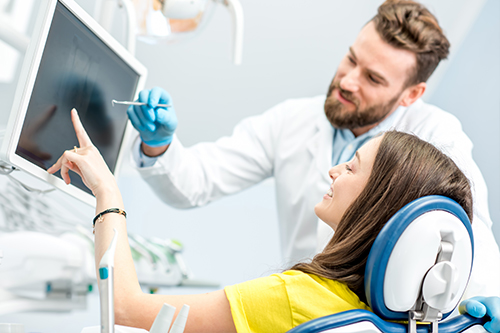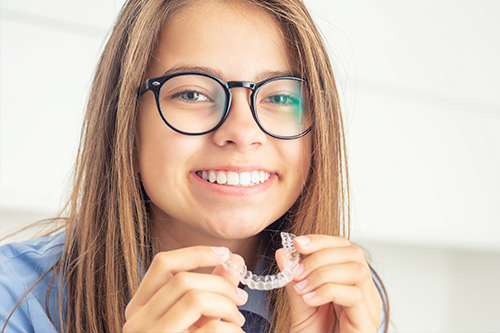Hablamos español!
Hablamos español!

Invisalign® offers a modern approach to straightening teeth: a series of clear, removable aligners that move teeth gradually and discreetly. Patients appreciate that the system blends contemporary digital planning with a treatment experience designed for everyday life — minimal hardware, predictable stages, and a focus on comfort. Below you'll find a practical guide to how Invisalign® works, what to expect during treatment, and how the process is managed in a clinical setting.
At its core, Invisalign® replaces traditional wires and brackets with a sequence of custom-made clear aligners. Each aligner is engineered to apply gentle, targeted pressure that guides individual teeth into more favorable positions. Because the movement is planned in small increments, the overall process is gradual and controlled, which helps maintain comfort while producing measurable progress over time.
The technology behind the system begins with a detailed digital scan of your teeth. Using three-dimensional imaging, clinicians can visualize current alignment issues and map out a complete movement plan from start to finish. That plan is translated into a series of aligners, each representing a small step toward the final position — when you swap one aligner for the next, you’re following a carefully calculated progression.
Invisalign® is suitable for a wide range of alignment concerns, from mild crowding and spacing to certain bite issues. The approach is especially appealing to adults and image-conscious teens because the aligners are virtually transparent and removable for short periods. A thorough clinical evaluation will determine whether the system is the most appropriate option for a given case, taking into account tooth movement goals and overall oral health.
By combining advanced imaging with evidence-based aligner design, Invisalign® systems provide several practical advantages. Treatment often requires fewer in-office adjustments than traditional braces, aligners are removable for eating and cleaning, and digital planning can improve predictability of movement. These factors contribute to a workflow that many patients find more convenient without sacrificing clinical control.

The first step in any aligner treatment is a focused consultation to evaluate your bite, tooth positions, and overall oral health. During this visit, the clinician will review your smile goals, examine periodontal and restorative considerations, and determine whether aligner therapy is suitable. This assessment sets the foundation for a safe and successful outcome.
We rely on high-resolution intraoral scans rather than traditional impressions in most cases. These digital records capture precise surface details and allow the team to analyze tooth angulation, spacing, and occlusion in three dimensions. The result is a clearer diagnostic picture and a faster path from consultation to treatment planning.
After the initial evaluation, a customized movement strategy is developed. That plan outlines the sequence of tooth movements and identifies any adjunctive needs — for example, optimizing bite contacts or coordinating with restorative work. Because each plan is individualized, the recommended approach is tailored to the specific anatomy and goals of the patient.

One of the defining features of contemporary aligner therapy is the ability to visualize treatment from beginning to end. Using advanced software, clinicians create a virtual treatment simulation that shows the intended progression of tooth movement. This preview helps set realistic expectations and allows for refinements before fabrication begins.
Each aligner in the series corresponds to a planned stage; wearing them in sequence achieves the cumulative shifts mapped out in the simulation. Because the digital workflow supports meticulous adjustments, clinicians can fine-tune the plan to address rotations, root positioning, and bite alignment with a high degree of control.
Clear communication is important during this phase: the simulation is reviewed with the patient so they understand how the plan meets their aesthetic and functional goals. If restorative or periodontal considerations are present, those are coordinated so the aligner plan complements any broader treatment objectives.

Once the treatment plan is finalized, aligners are manufactured to exact specifications using clear, medical-grade materials. The production process focuses on consistent thickness and fit so each tray delivers the intended pressure without unnecessary irritation. Many patients notice the aligners feel sleek and unobtrusive compared with older styles of removable appliances.
Small, strategic features such as attachments or built-in pressures are incorporated when necessary to facilitate complex movements. These elements are discreet and designed to work seamlessly with the aligner trays, enhancing the system's capacity to address a broad range of alignment challenges while preserving the low-profile aesthetic.
Comfort and oral health are priorities during manufacturing. Smooth edges, a tailored fit, and biocompatible materials all contribute to an experience that supports consistent wear — a critical factor for treatment success — while minimizing interference with speaking and daily activities.

Aligner therapy is not a set-and-forget solution; it requires periodic check-ins so clinicians can monitor progress and make any necessary refinements. Appointments are typically scheduled at regular intervals to ensure that movements are tracking as planned and to provide replacement aligners as you advance through the series.
Patient engagement is a key component of successful outcomes. Because aligners are removable, maintaining the recommended wear time each day is essential. Clinicians work with patients to build realistic routines and provide practical tips for cleaning, storage, and troubleshooting common concerns like minor fit adjustments.
At the end of active alignment, retention strategies are implemented to preserve the results. Retainers — often clear and conveniently designed — help stabilize teeth as surrounding tissues adapt. Follow-up care focuses on maintaining both the cosmetic and functional improvements achieved during treatment.
Short, informative videos that explain treatment steps, day-to-day care, and clinical perspectives on clear aligner therapy.
*Invisalign® is a registered trademark of Align Technology, Inc.
Invisalign® combines precise digital planning with patient-friendly aligner design to deliver predictable, discreet tooth movement. If you're interested in learning whether clear aligner therapy is a fit for your smile, our team can explain the clinical considerations and walk you through the diagnostic process. Contact Everything Smiles for more information and to arrange a consultation.
There are many options for patients who want to avoid metal braces! The most popular alternative orthodontic treatment is Invisalign®, which are clear plastic aligners designed to straighten teeth. After an examination of your teeth, your dentist will determine which option is best suited to your wants and needs.
According to the Invisalign® website, the cost for treatment is approximately the same as the cost for metal braces. A portion of this cost may be covered by your insurance. Please call us to set up a consultation and discuss potential payment plan options.
The first step is to schedule a consultation with your doctor, so they can devise a treatment plan that is best suited to your individual dental needs. Once approved, you will receive your first set of aligners. Your doctor will then regularly monitor the movement of your teeth and new aligners will be ordered according to the progress made in your treatment plan.
Invisalign® aligners are made of clear, flexible plastic. The company received a patent for this material – SmartTrack® – to be used exclusively for Invisalign treatment purposes. These aligners are FDA approved and nearly invisible!
Your doctor will give you an estimate regarding how long your Invisalign® treatment should take, which will depend on your specific needs. The average length of time for treatment is approximately 12-18 months. However, some patients may see results far sooner. Remember to wear your aligners exactly as instructed by your doctor to obtain the best results.
Your doctor will most likely recommend that you wear retainers following your Invisalign® treatment. This is a precaution that will prevent your teeth from shifting back to their original positioning. It is important to follow your doctor's instructions exactly to ensure long-lasting results.
You must wear your aligners for up to 22 hours daily. You may remove them for eating, drinking and regular oral hygiene.
No. Unlike braces, you may eat whatever you like as long as you remove the aligners before eating. Prior to placing the aligners back on, it is important to brush your teeth and the aligners after you eat.
Like any orthodontic treatment, there is a short adjustment period. The more you speak with the aligners on, the quicker you will adjust.
There will be some pressure and minor discomfort for a day or two after each initial insertion. This is a sign that your teeth are moving sequentially into their final position.
It is recommended that you remove your aligners prior to chewing gum as the gum will stick to the aligners.
We discourage smoking with aligners as the cigarette smoke will tend to discolor them.
Brushing them with toothpaste will keep them fresh and clean.
Regular office visits are every five to six weeks. This will ensure that your Invisalign treatment is progressing as planned.
All orthodontic patients are instructed to wear their retainers at night indefinitely. Sleeping with your retainers in at night will ensure a healthy bite and maintain the new position of your teeth.
Yes, if their teeth, including second molars, have grown in completely.
Invisalign is a system of custom-made, clear plastic aligners designed to move teeth gradually into a desired position. Your orthodontic plan is created using 3-D digital imaging to map a sequence of movements, and each aligner in the series applies gentle pressure to specific teeth. Patients change aligners at regular intervals to continue progress until the planned alignment is achieved.
The treatment is removable for short periods, which allows for normal eating and easier oral hygiene compared with fixed appliances. Because the aligners are transparent and tailored to your smile, they are less noticeable during daily activities. Regular check-ins with your provider monitor progress and make any necessary refinements to the plan.
Many adolescents and adults with mild to moderate alignment issues are good candidates for Invisalign, including those with crowding, spacing, and some bite concerns. A thorough evaluation by a qualified dentist or orthodontist will consider tooth movement needs, jaw alignment, periodontal health, and overall oral hygiene. Complex skeletal discrepancies or severe bite problems may require additional orthodontic approaches or combined treatments.
Age alone is not a disqualifier; treatment suitability depends on dental development and oral health rather than chronological age. Candidates must be committed to wearing aligners as instructed and maintaining consistent follow-up appointments to achieve the planned outcome. Your provider can explain whether aligners alone will meet your treatment goals or if adjunctive therapies are recommended.
Your initial consultation at Everything Smiles begins with a clinical exam and a discussion of your goals and dental history. The provider will perform a digital scan or take impressions, capture photographs and x-rays as needed, and explain how Invisalign would address your specific concerns. This visit also includes a review of expected treatment steps and an opportunity to view a projected outcome using digital simulations.
During the consultation you can ask about treatment milestones, appointment frequency, and daily wear requirements so you understand the commitment involved. The team will assess overall oral health and recommend any necessary preliminary care before starting aligners, such as addressing cavities or gum inflammation. Clear communication at this stage helps set realistic expectations for the treatment timeline and results.
Aligners are manufactured from your individualized 3-D digital model to match each planned stage of tooth movement. After your digital scan, the treatment plan is refined and approved, and a series of aligners is produced to reflect incremental changes. Each aligner is worn for a prescribed period, typically changing to the next set as directed by your provider.
Fitting involves verifying that the aligner seats properly and making minor adjustments or attachments if required to facilitate certain movements. Attachments are small tooth-colored bumps bonded to specific teeth to help the aligner grip and move them more predictably. Your provider will show you how to insert and remove aligners and will schedule follow-up visits to confirm that movement is proceeding as planned.
Treatment length varies based on the complexity of the case and the specific movements needed, commonly ranging from several months to over a year for more involved corrections. The digital plan provides an estimated timeline that can be refined as treatment progresses and as your provider monitors tooth movement. Compliance with daily wear guidelines is one of the most important factors that affects how quickly results are achieved.
Progress is checked at regular intervals to verify alignment and to address any needs for additional refinements or new aligners. If midcourse adjustments are required, your provider will update the plan to keep progress on track. Clear communication and adherence to scheduled visits help ensure an efficient treatment process.
Clean aligners daily using a soft brush and lukewarm water, and avoid hot water that can warp the plastic. Remove aligners before eating and drinking anything other than plain water to prevent staining and reduce the risk of trapping food against your teeth. Rinse aligners each time you remove them and store them in their case to keep them sanitary when not in use.
Maintain excellent oral hygiene by brushing and flossing after meals before putting aligners back in, which helps prevent decay and gum problems during treatment. Continue regular dental checkups and professional cleanings so your provider can monitor oral health while teeth are moving. If you notice persistent discomfort, damage to an aligner, or signs of gum irritation, contact your dental team promptly for guidance.
Some patients experience a brief adjustment period during which speech may sound slightly different, particularly with complex movements or newly placed aligners. Most people adapt within a few days as the tongue and lips learn to accommodate the aligner surfaces. If speech changes persist beyond the initial adaptation phase, your provider can evaluate fit and suggest exercises to speed recovery.
Mild discomfort or pressure is normal for the first few days after switching to a new aligner as teeth begin to move. This sensation typically subsides as your mouth adjusts, and over-the-counter pain relief or soft foods can help relieve temporary soreness. Report any severe or prolonged pain so the dental team can assess for fit issues or other contributing factors.
Invisalign is capable of addressing a broad range of alignment problems, including many bite irregularities and specific tooth movements such as rotations, intrusions, and extrusions. Advances in aligner technology and the use of attachments have expanded the types of movements achievable with removable aligners. However, certain severe skeletal discrepancies or complex orthodontic needs may be better managed with traditional braces or combined surgical-orthodontic approaches.
During your evaluation, the provider will determine whether clear aligners alone can meet your objectives or if adjunctive measures are necessary to achieve optimal results. Treatment planning takes into account tooth movement predictability and long-term function, not just cosmetic alignment. Your clinician will explain the rationale for the recommended approach and how it supports both aesthetics and oral health.
After active alignment is complete, most patients transition to retainers to maintain tooth position and prevent relapse. Retention protocols vary based on individual needs and the amount of movement achieved, and your provider will recommend the type and wear schedule for your retainers. Regular follow-up visits for monitoring help ensure stability and allow for timely intervention if minor shifts occur.
Maintaining good oral hygiene and attending routine dental exams remain important after treatment to preserve both the health and appearance of your smile. Your dental team may provide guidance on long-term care, nightguard options if you grind your teeth, and periodic retainer checks. Ongoing communication with your provider helps protect your investment in the smile you worked to achieve.
Invisalign offers options specifically designed for teenagers, addressing the unique developmental and compliance considerations of this age group. Teen aligners can include compliance indicators to help track wear time, and treatment plans account for erupting permanent teeth and growth changes. Parental involvement and regular dental visits support successful outcomes for adolescent patients.
Care for teen patients may include additional monitoring to ensure aligners fit as new teeth emerge, and the provider will adjust the plan if eruption patterns affect movement. Education about proper wear, hygiene, and the importance of following instructions is a key part of successful teen treatment. With appropriate oversight, many teenagers achieve predictable results using clear aligners while maintaining an active lifestyle.
